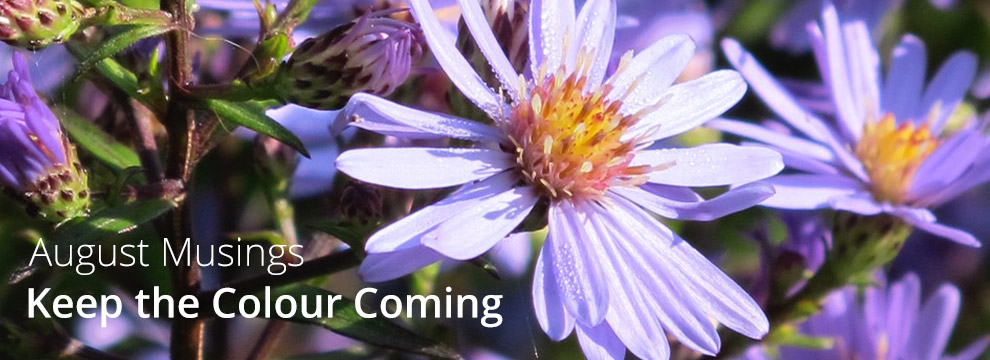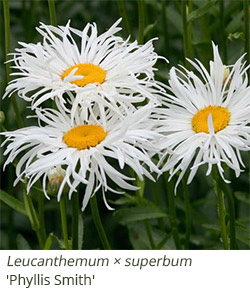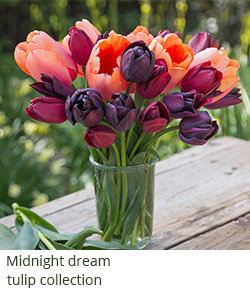For the last twenty or so years we've had much warmer weather than we used to, so it's much easier to keep the colour coming right up
until late October.
There are two main groups of plants that really shine from August onwards. Most southern hemisphere plants, the one used to evenly balanced days, get into their stride now. Among the best are dahlias, salvias, penstemons, fuchsias and gauras. Planted now, they will lift the garden until the first frosts descend.
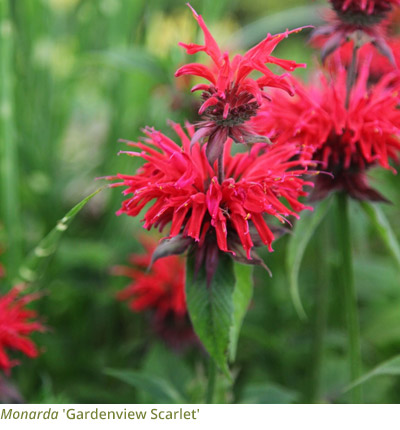 The second most useful group are the taller North American prairie plants. These are mainly woody stemmed and they include asters, veronicastrums, monardas and rudbeckias. They can all be planted now and they will come back year after year. More importantly they fade into winter so these shouldn’t be cut back until late January at the earliest. The second most useful group are the taller North American prairie plants. These are mainly woody stemmed and they include asters, veronicastrums, monardas and rudbeckias. They can all be planted now and they will come back year after year. More importantly they fade into winter so these shouldn’t be cut back until late January at the earliest.
Southern hemisphere plants come in far more vivid colours so their pigment packed petals glow at this time of year. Dahlias are one of the most useful and they also make tremendous cut flowers. You could leave the tubers in the ground in milder gardens. However if you're colder, lift the tubers by November. Keep the soil round the tubers and add some more dry compost and store them in plastic trays in a frost proof place. ‘Thomas A. Edison’ will deliver a stand of deep purple decorative flowers. It’s been around since 1929, so this golden oldie has stood the test of time. The deep purple flowers would set off ‘Jescott Julie’, a double orchid dahlia, really well because the curled orange petals have a plum reverse. It's that contrast of peach and plum that makes this rather exotic dahlia so special.
The well named ‘Café au Lait’, just like the colour of milky coffee, is highly popular as a cut flower because it’s a great foil for brighter colours. It's hard to tell in some lights whether the flowers are colour washed in peachy pink or butterscotch, but they look sensational on a mellow autumn afternoon. Perhaps the most spectacular dahlias of all are the ones with spiky petals though. They’re labelled semi-cactus or cactus and ‘Ambition’ hovers between violet, pink and purple so it jumps out of the border in all the right ways.
 The other great thing about dahlias is they can add rich touches of almost black foliage or flower. Used with bright yellow daisies these will add an ornate touch of richness. The classic red peony flowered ‘Bishop of Llandaff’ has finely divided black foliage and post office box bee friendly flowers in warm red. It's almost a centenarian, having been named in 1922, but it’s still in most people's Top Ten. The really dark reds also work well and ‘Chat Noir’ is a strong dahlia with an architectural shape. Dahlia 'Nuit d'Eté' is gentler, with a touch of black to its heart. The other great thing about dahlias is they can add rich touches of almost black foliage or flower. Used with bright yellow daisies these will add an ornate touch of richness. The classic red peony flowered ‘Bishop of Llandaff’ has finely divided black foliage and post office box bee friendly flowers in warm red. It's almost a centenarian, having been named in 1922, but it’s still in most people's Top Ten. The really dark reds also work well and ‘Chat Noir’ is a strong dahlia with an architectural shape. Dahlia 'Nuit d'Eté' is gentler, with a touch of black to its heart.
Salvias also add vivid touches to the border. Most taller salvias are either frost hardy or tender. You can bed them in during August and then you can either discard them, or keep them in a frost free greenhouse or conservatory. Many gardeners take cuttings and this isn't onerous. Fill a small half size seed tray, or a small pot, with coarse horticultural sand. Water well and then snip or pull side shoots away and plunge them into the sand. Keep them damp and frost free and pot them up next spring. You could use the same seed tray to take other cuttings of fuchsias or pelargoniums.
Many tall deep blue salvias have black calices and stems and Salvia guaranitica 'Black and Blue' gets its name for this reason. There are plenty of smaller, shrubbier salvias that will come through the winter if they're given a warm position and good drainage. These tend to be woodier and their smaller flowers have wide lips. They'll often continue flowering until November and this really helps the bees and late flying butterflies. The deep red ‘Royal Bumble’ is an excellent salvia. Or you could opt for ‘Mirage Cherry Red’ or ‘Mirage Deep Purple’. These small flowered salvias aren’t showy: they provide flecks of colour over many months.
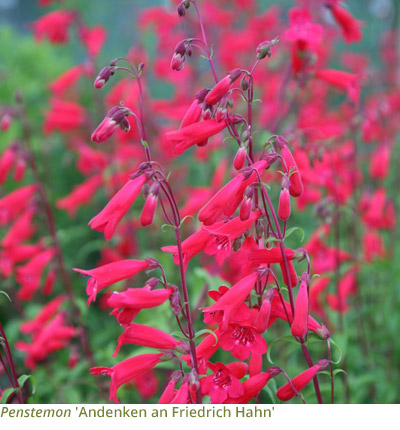 Penstemons come in a range of colours from pale pink, to garnet red, to deep purple and opalescent mauve. Their chief contribution is their upright shape because this is the season of mound forming daisies. Penstemons break up the monotony by providing a vertical presence that’s rare now. Spires are always popular with bees because the flowers open over weeks, usually from the bottom upwards. They’re very useful among silver leaved plants, particularly the almost black ‘Raven’. Add the pink and purple flowered Origanum laevigatum 'Herrenhausen' and the finely divided foliage of Artemisia ‘Powis Castle’ and you’ll create a shimmering combination that will please the bees and butterflies for weeks. Perhaps a dash of blue, in the shape of Perovskia ‘Blue Spire’, will make ‘Raven’ look even more dynamic. ‘Sour Grapes’ has shades of grey and blue and the classic ‘Andenken an Friedrich Hahn’, once sold as ‘Garnet’, has deep red flowers that look tremendous with blues. Penstemons come in a range of colours from pale pink, to garnet red, to deep purple and opalescent mauve. Their chief contribution is their upright shape because this is the season of mound forming daisies. Penstemons break up the monotony by providing a vertical presence that’s rare now. Spires are always popular with bees because the flowers open over weeks, usually from the bottom upwards. They’re very useful among silver leaved plants, particularly the almost black ‘Raven’. Add the pink and purple flowered Origanum laevigatum 'Herrenhausen' and the finely divided foliage of Artemisia ‘Powis Castle’ and you’ll create a shimmering combination that will please the bees and butterflies for weeks. Perhaps a dash of blue, in the shape of Perovskia ‘Blue Spire’, will make ‘Raven’ look even more dynamic. ‘Sour Grapes’ has shades of grey and blue and the classic ‘Andenken an Friedrich Hahn’, once sold as ‘Garnet’, has deep red flowers that look tremendous with blues.
Stonecrops, or sedums, may not be South American dazzlers, but their succulent like foliage comes in shades of ebony, or iridescent pink and grey. They store their own water in their leaves, so they never look tired when August strikes, and their pink or pink-red flowers also fade beautifully from raspberry ripple to chocolate sauces. I would never be without these butterfly and bee landing stages. Their flat topped domes keep their shape as winter approaches and sedums are easy to maintain. Just cut them back in November. ‘Matrona’, a statuesque sedum with grey-pink foliage reminiscent of a pigeon’s breast, is particularly good with pink diascias such as ‘Little Dancer’. 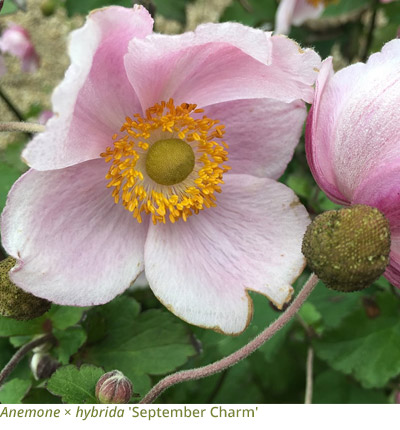 Or you could use the handsome ‘Karfunkelstein’, raised in Germany by Ernst Pagels. This sedum has foliage that colours up to a mixture of beetroot and soot and the reddish flowers add a further smouldering touch. Or you could use the handsome ‘Karfunkelstein’, raised in Germany by Ernst Pagels. This sedum has foliage that colours up to a mixture of beetroot and soot and the reddish flowers add a further smouldering touch.
Fuchsias also come into their own now and hardy fuchsias, although out of fashion, make perfect partners for Japanese anemones whether it’s the larger flowered purple and red ‘Mrs Popple’ or the more willowy 'Riccartonii'. Both will reach at least 3 feet in height, allowing Japanese anemones such as the pure white ‘Honorine Jobert’ or the cool pink ‘September Charm’ to rise above them. All prefer a cool root run in good soil and it’s vital that both avoid midday sun. If you’ve a path edged by a narrow border, this combination works well even if there’s a hedge.
I might also add an equally willowy touch of blue, using Ceratostigma willmottianum FOREST BLUE (‘Lice’) (PBR). This will provide a series of sapphires in a border and the reddening foliage resembles flickering flames. It’s often still going in November and, as long as it isn’t cut back until next spring, it will overwinter. Wait for the buds to break in the following spring and then cut back to the uppermost shoot. Don’t slaughter it in spring: it will hate it!
Asters are at their best now, although the names have been botanically shuffled. If they’re of European extraction they’re mainly still listed under Aster and they’re also tolerant of drier conditions. Aster × frikartii 'Mönch' is the longest flowering of all, with long-rayed lavender daisies. Use it next to the crisp yellow and brown daisy, Rudbeckia fulgida var. deamii.
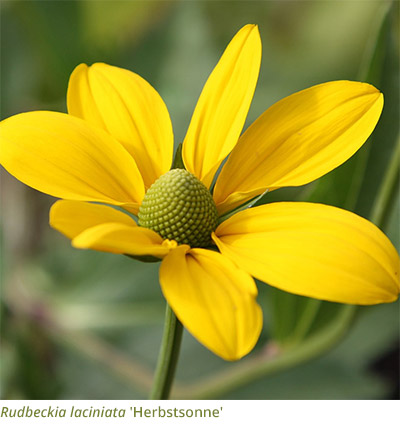 North American asters, which are less drought tolerant, have been renamed and our most garden worthy ones are now listed under Symphyotrichum. ‘Little Carlow’ is a top notch aster with tiny blue flowers that spring from buds etched in red diagonal lines, so it’s good for weeks. The fine foliage, reminiscent of a burning bush, is also handsome so this is a perfect candidate for a key position at the front, or corner of a border. Taller yellow daisies can be missed in the depths, whether it’s the mid-yellow Rudbeckia laciniata ‘Herbstsonne’. This has cool green cones and a slender silhouette. North American asters, which are less drought tolerant, have been renamed and our most garden worthy ones are now listed under Symphyotrichum. ‘Little Carlow’ is a top notch aster with tiny blue flowers that spring from buds etched in red diagonal lines, so it’s good for weeks. The fine foliage, reminiscent of a burning bush, is also handsome so this is a perfect candidate for a key position at the front, or corner of a border. Taller yellow daisies can be missed in the depths, whether it’s the mid-yellow Rudbeckia laciniata ‘Herbstsonne’. This has cool green cones and a slender silhouette.
I also love the spoon shaped yellow petals of Rudbeckia subtomentosa ‘Henry Eilers’, another slender daisy that presents itself at eye height. Use in front of a vertical such as Veronicastrum virginicum ‘Fascination', with lavender-blue spires. The flowers fade to provide a tapering green head. Or add a touch of red wine with the fluffy heads of Eupatorium maculatum (Atropurpureum Group) 'Riesenschirm'. This is an August butterfly magnet and so good with all yellows.
There’s plenty of time to add some razzle dazzle to your borders so that you can enjoy your garden for longer!
|



